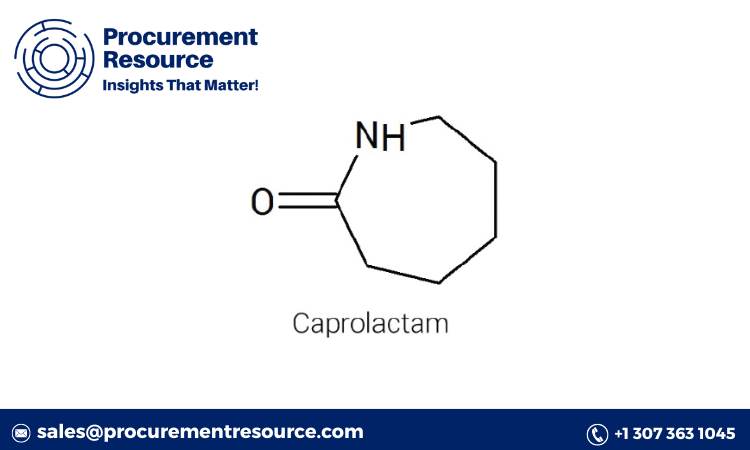Caprolactam, a key raw material primarily used in the production of nylon-6 fibers and resins, plays a crucial role in industries such as textiles, engineering plastics, and automotive parts. With its extensive applications in both consumer goods and industrial components, tracking the price of caprolactam is critical for manufacturers, traders, and investors involved in these industries. In this blog, we explore the latest trends in the caprolactam market, analyze key price determinants, and offer insights into what’s driving changes in the cost of this important chemical.
Overview of Caprolactam
Caprolactam (C6H11NO) is an organic compound that undergoes polymerization to produce nylon-6. Nylon-6 is widely used in textiles (for clothing and carpets), engineering plastics, automotive components, electrical applications, and packaging films. Given its widespread use, fluctuations in caprolactam prices impact multiple sectors.
Request For Sample: https://www.procurementresource.com/resource-center/caprolactam-price-trends/pricerequest
Caprolactam Latest Price Trends
Global Price Dynamics (Q3 and Q4 2024)
As of the latter part of 2024, the global caprolactam market has been experiencing notable price fluctuations driven by various factors:
- Raw Material Costs: Caprolactam production relies heavily on petrochemical-derived inputs such as cyclohexane. Fluctuations in crude oil prices, which feed into the cost of cyclohexane, have contributed to volatility in caprolactam prices. While oil prices have generally stabilized after a period of surging inflation earlier in the year, supply disruptions in the petrochemical industry have created uncertainty.
- Supply Chain Bottlenecks: Logistics issues, particularly post-pandemic disruptions in shipping routes and port congestions, continue to challenge the steady flow of raw materials and finished products. These bottlenecks have led to supply shortages in certain regions, contributing to a spike in prices in late Q3.
- Demand from Downstream Sectors: The textile and automotive industries are major consumers of nylon-6, and their recovery post-pandemic has boosted demand for caprolactam. The automotive industry, in particular, is seeing heightened demand for lightweight components made from nylon-6 due to its use in energy-efficient vehicles.
- Energy Costs: Energy prices play a significant role in determining the production costs of caprolactam, especially in energy-intensive regions. Rising electricity costs in Europe and Asia, driven by geopolitical tensions and a push for renewable energy, have added pressure on caprolactam producers, further driving up prices.
- Geopolitical Instability: The ongoing global geopolitical tensions, especially in key production and trading hubs, have contributed to supply chain uncertainties. Disruptions in energy supplies, export bans, and trade restrictions in regions like Eastern Europe and the Middle East have directly impacted caprolactam prices.
Regional Price Overview
- Asia-Pacific: Asia, particularly China and India, remains the largest producer and consumer of caprolactam. As of Q4 2024, prices in China have been trending upwards due to increased demand from the automotive and textile sectors. Additionally, stricter environmental regulations have put pressure on production capacities, leading to tighter supplies and higher prices.
- Europe: European prices have seen sharp fluctuations as well. Rising energy costs in the European Union, coupled with decreased production capacities in some plants due to environmental regulations, have caused significant price hikes. The European automotive industry’s rebound has kept demand high, further supporting increased prices.
- North America: In North America, caprolactam prices have remained relatively stable, though the region has not been immune to supply chain issues and rising energy costs. With growing demand for engineering plastics, prices have remained on the higher side, particularly for importers relying on global supply chains.
Factors Driving Price Movements
Several key factors influence the pricing dynamics of caprolactam:
- Crude Oil Prices: Since caprolactam is derived from petrochemical feedstocks, fluctuations in crude oil prices directly impact its cost. Volatile oil prices continue to be a primary driver of caprolactam price trends.
- Economic Conditions: Global economic slowdowns or recoveries affect demand for caprolactam-containing products like nylon-6. Slower economic growth in Europe and North America has tempered demand, while robust industrial growth in Asia has bolstered it.
- Environmental Regulations: In regions where environmental concerns are paramount, stringent regulatory requirements have limited production capacities, reducing supply and driving prices upwards.
- Technological Advancements: Improvements in production processes, such as cost-efficient and sustainable production methods, are expected to reduce production costs in the long term. However, in the short term, transitioning to greener technologies has added costs for producers.
Future Outlook
Looking ahead, several trends may impact caprolactam prices:
- Sustainability Initiatives: The growing focus on sustainability in the chemical industry could shift production methods, pushing prices higher in the short term due to investment in greener technologies. Over time, these innovations may stabilize prices by reducing reliance on traditional petrochemicals.
- Global Demand for Electric Vehicles (EVs): As the automotive industry shifts toward electric vehicles, the demand for lightweight materials, such as nylon-6, will continue to rise, driving up caprolactam demand.
- Geopolitical and Economic Stability: Any easing in geopolitical tensions or a stronger economic recovery could stabilize or lower prices, whereas continued instability will likely keep prices elevated.
The caprolactam market is witnessing significant price fluctuations, driven by a combination of supply chain disruptions, energy costs, raw material availability, and increasing demand from key industries like automotive and textiles. Monitoring these factors will be crucial for stakeholders in the caprolactam supply chain, as price volatility is expected to persist into the near future.
As the industry moves toward more sustainable practices and grapples with geopolitical challenges, market participants will need to stay agile and prepared for ongoing changes in caprolactam pricing trends.
Contact Us:
Company Name: Procurement Resource
Contact Person: Endru Smith
Email: sales@procurementresource.com
Toll-Free Number: USA & Canada - Phone no: +1 307 363 1045 | UK - Phone no: +44 7537171117 | Asia-Pacific (APAC) - Phone no: +91 1203185500
Address: 30 North Gould Street, Sheridan, WY 82801, USA
 :
https://pin.it/1X02BcMYy
:
https://pin.it/1X02BcMYy

